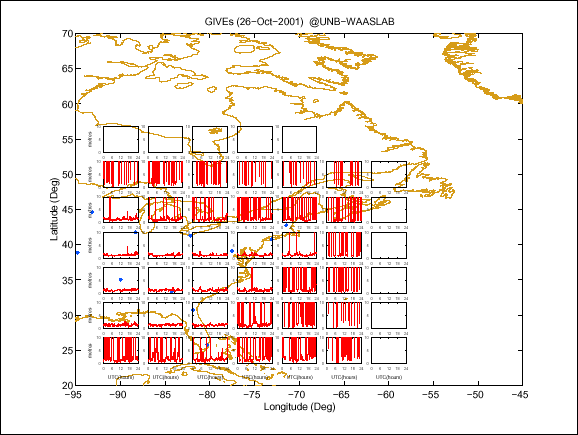

The blue dots indicate the locations of the current WAAS stations within the mapped area. IGD values for grid points on the periphery of the WAAS service area are noisy due to reduced satellite pierce point density. Note that the following peripheral grid points are not depicted on any of the maps:
- (10, [-75, -70])
- (15, [-155, -150]); (15, [-100, -65])
- (20, [-155, -150])
- (25, -155)
- (65, [-110, -80]).
To see a map showing all of the ionospheric grid points for which vertical delays were provided by AOR-W and the corresponding GIVE coverage areas as well as the previously monitored points and coverage areas, click here. The dashed red line indicates the previous AOR-W GIVE coverage area. This map is no longer current.
Occasional gaps of some minutes or hours in the plots are due to data loss at UNB (power outages or other causes) or WAAS signal outages. Small gaps or breaks in the plots indicate that the interval between WAAS message IGD updates has exceeded 5 minutes. Occasional spikes in the IGD plots reflect IGD values of 63.875 metres in the WAAS message and are of unknown origin.
PDF files containing the plots of IGD or GIVE values for eastern North America since 28 July 2001 and for western North America and eastern Alaska since 28 April 2002, as obtained from AOR-W, and since 4 May 2006 from Galaxy XV and Anik F1R, may be downloaded by entering the date in the fields below:
We have assembled the daily maps for eastern North America for the month of March 2002 into a QuickTime movie (double-click on the movie to replay it):
- High resolution (1200 x 900 bpi; needs a large display)
- Low resolution (600 x 450 bpi).
From time to time, we modify our archiving and map generation procedures. A list of changes to our system is available. This list also includes reports of gaps in our map archives.
For further information, please contact Hyunho Rho or Richard Langley.
The UNB WAAS-related research is supported by Nav Canada.